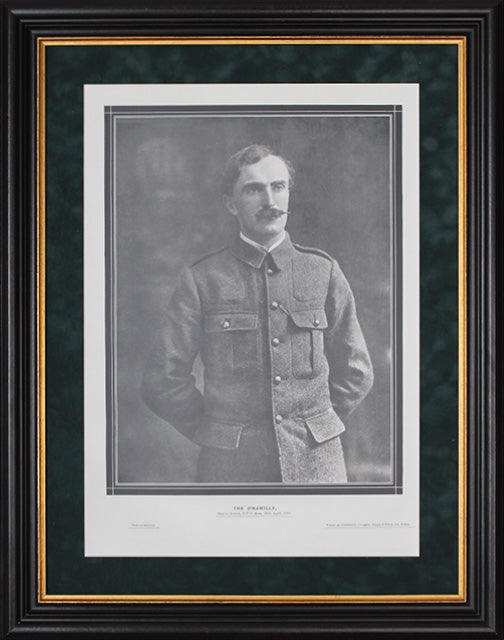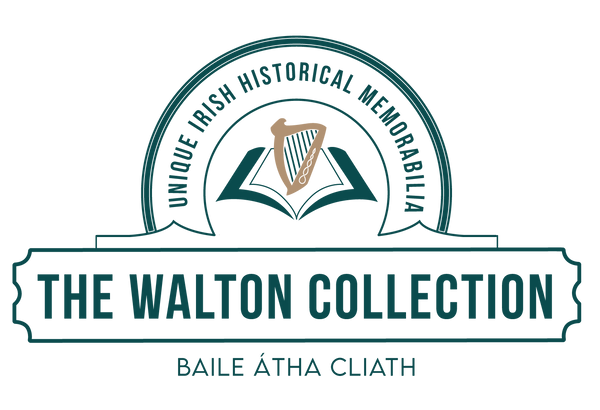The Walton Collection
The O'Rahilly - 1916 Poster
The O'Rahilly - 1916 Poster
Couldn't load pickup availability
A rare Michael Joseph O'Rahilly 1916 commemorative poster.
Michael O'Rahilly was born on 22nd April 1875. Also known as 'The O'Rahilly', he was an Irish republican and nationalist. He was a founding member of the Irish Volunteers in 1913 and served as Director of Arms. Despite opposing the action, he took part in the Easter Rising in Dublin and was killed in a charge on a British machine gun post covering the retreat from the Dublin GPO during the fighting.
O'Rahilly was born in Ballylongford, County Kerry, and was educated at Clongowes Wood College .As an adult, he became a republican and a language enthusiast. He joined the Gaelic League and became a member of An Coiste Gnotha, its governing body. He married Nancy Brown on 15 April 1899 in New York and the couple had six sons together.
O'Rahilly was a founding member of the Irish Volunteers in 1913 wherein he served as the Irish Volunteers' Director of Arms. O'Rahilly was not party to the plans for the Easter Rising, nor was he a member of the Irish Republican Brotherhood (IRB), but he was one of the main people who trained the Irish Volunteers for the coming fight. The planners of the Rising went to great lengths to prevent those leaders of the Volunteers who were opposed to unprovoked, unilateral action from learning that a rising was imminent until the last moment, including its Chief-of-Staff Eoin MacNeill, Bulmer Hobson, and O'Rahilly.
O'Rahilly took instructions from MacNeill, who had countermanded his orders from Pearse, and O'Rahilly spent the night driving throughout the country, informing Volunteer leaders in Munster that they were not to mobilise their forces for planned manoeuvres on Sunday. Arriving home, he learned that the Rising was about to begin in Dublin on the next day, Easter Monday, 24 April 1916. Despite his efforts to prevent the action he set out to Liberty Hall to join the Irish Volunteers and Irish Citizen Army troops.
Arriving in his motorcar, he gave one of the most quoted lines of the rising – "Well, I've helped to wind up the clock - I might as well hear it strike!" Another famous, if less quoted line, was his comment to Markievicz, "It is madness, but it is glorious madness."
He fought with the GPO garrison during Easter Week and was badly wounded in the retreat to Great Britain Street (now Parnell Street). A British machine-gun at the intersection of Great Britain and Moore streets cut him and several of the others down. O'Rahilly eventually fell down in Sackville Lane (now O'Rahilly Parade). He was wounded diagonally from shoulder to hip by sustained fire from the machine-gunner. According to ambulance driver Albert Mitchell (in a witness statement more than 30 years later), O'Rahilly still clung to life 19 hours after being severely wounded, long after the surrender had taken place on Saturday afternoon.
The following is an extract from Mitchell's account:
"While driving through Moore Street to Jervis Street Hospital one afternoon towards the end of the week the sergeant drew my attention to the body of a man lying in the gutter in Moore Lane. He was dressed in a green uniform… We were about to lift it up when a young English officer stepped out of a doorway and refused to allow us to touch it. I told him of my instructions from H.Q. but all to no avail…..
We came back again about 9 o'clock that night. The body was still there and an officer guarding it, but this time I fancied I knew the officer – he was not the one I met before. I asked why I was not allowed to take the body and who was it? He replied that his life and job depended on it being left there. He would not say who it was. I never saw the body again but I was told by different people that it was The O’Rahilly."
O'Rahilly had written a message to his wife on the back of a letter he had received in the GPO from his son. The text reads:
‘Written after I was shot. Darling Nancy I was shot leading a rush up Moore Street and took refuge in a doorway. While I was there I heard the men pointing out where I was and made a bolt for the laneway I am in now. I got more [than] one bullet I think. Tons and tons of love dearie to you and the boys and to Nell and Anna. It was a good fight anyhow. Please deliver this to Nannie O' Rahilly, 40 Herbert Park, Dublin. Goodbye Darling.’
Originally printed and published by O'Loughlin, Murphy and Boland, using a photo by Lafayette., the text below the photograph simply states: "THE O'RAHILLY , Shot in Action, G.P.O. Area, 28th April , 1916".
This is a remarkable reproduction on 210 gsm satin art paper , beautifully mounted on a mottled green suede background and set behind glass in a handmade, aged dark mahogany finish frame with a gold gilt sightline.


